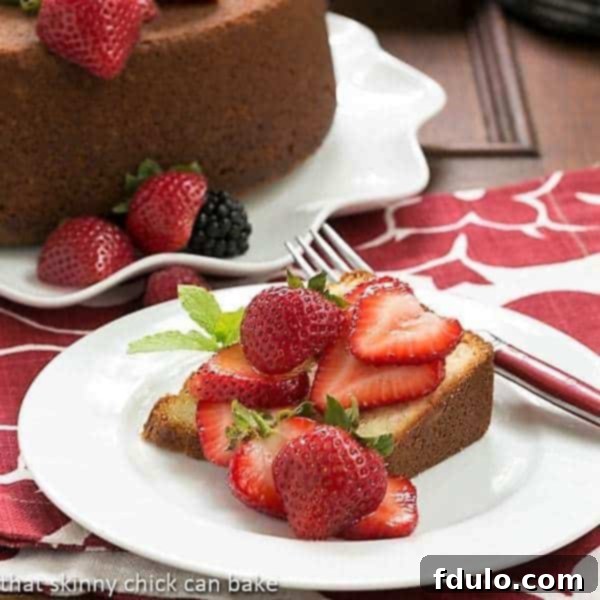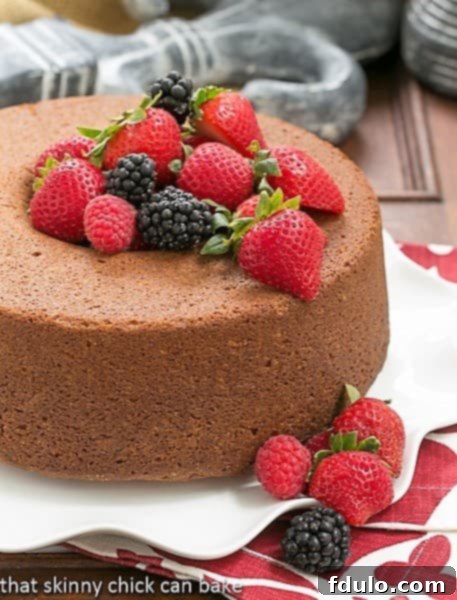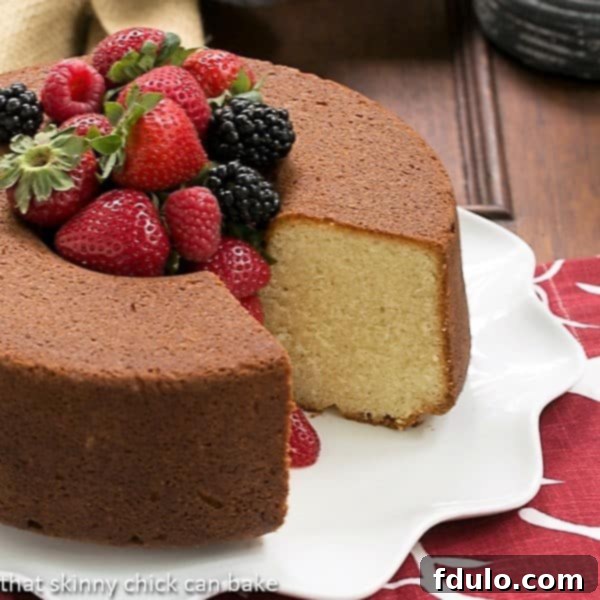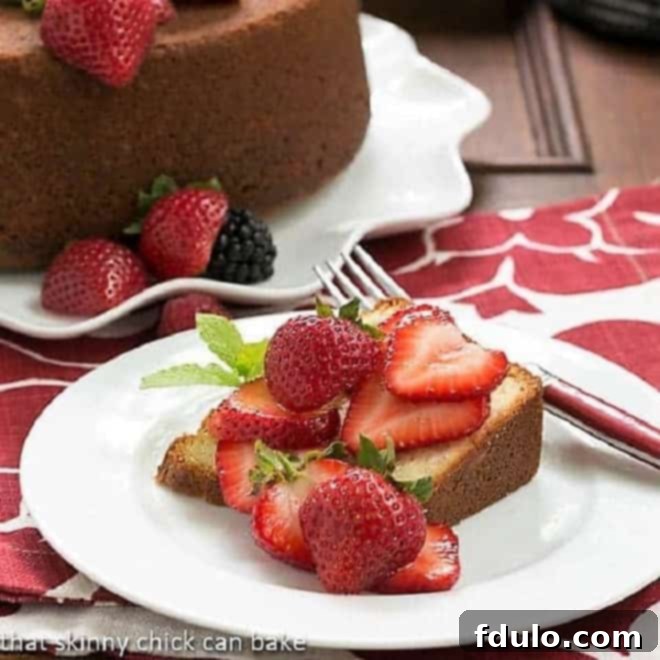Classic Vanilla Pound Cake: Your Ultimate Guide to a Perfectly Moist & Versatile Dessert
There are few desserts as universally cherished and inherently versatile as a classic Vanilla Pound Cake. This humble yet elegant cake serves as the perfect canvas for an endless array of toppings and accompaniments, making it an ideal choice for any occasion. Whether you prefer the simplicity of fresh seasonal berries, the richness of a scoop of vanilla bean ice cream, or a decadent drizzle of warm fudge sauce, this cake effortlessly adapts to your culinary whims.
Beyond its solo performance, a simple pound cake recipe also offers incredible flexibility. Slices can be transformed into the base for magnificent trifles, layered parfaits, or even repurposed into delectable French toast. Its dense yet tender crumb holds up beautifully, absorbing flavors and textures without becoming soggy, making it a true kitchen hero.

Why You Need This Classic Vanilla Pound Cake in Your Life
Imagine packing up for an annual summer getaway to visit family, and you’ve got a homemade Vanilla Pound Cake nestled safely amongst your belongings. That’s exactly what happened on one occasion, as my spry 87-year-old mother-in-law had just frozen eight quarts of fresh strawberries, eagerly awaiting a perfect pairing. This cake was the ideal companion, a testament to its comforting and shareable nature. But beyond family gatherings, here’s why this vanilla pound cake recipe is a must-have in your baking repertoire:
- Unmatched Versatility: This simple vanilla pound cake is incredibly adaptable. Its mild, sweet flavor allows it to complement almost any topping, making it suitable for breakfast, brunch, or a sophisticated dessert.
- Endless Serving Options: Enjoy individual slices with a vibrant Fresh Strawberry Compote, a medley of mixed berries, or a dollop of sweetened whipped cream. For a more indulgent treat, pair it with ice cream and a luscious fudge or caramel sauce. Or, keep it elegantly simple with a dusting of powdered sugar.
- Creative Culinary Applications: Don’t let leftovers go to waste! Cubed pound cake can be layered with berries, fruit jam, and whipped cream to create stunning trifles or parfaits. It’s a fantastic base for summer shortcakes or even a unique twist on bread pudding.
- A True Crowd-Pleaser: The rich, buttery flavor and satisfyingly dense texture of this pound cake appeal to almost everyone. It evokes a sense of nostalgia and comfort, making it a beloved dessert that’s sure to earn rave reviews.
The Enduring Appeal of Pound Cake: A Brief History
The pound cake holds a special place in the history of baking, tracing its origins back to the 18th century. Its name is a direct reflection of its original recipe, which famously called for a pound each of butter, sugar, flour, and eggs. This straightforward, balanced ratio made it an incredibly popular and accessible cake for home bakers, long before the advent of modern leavening agents like baking powder. The simplicity of its ingredient list and the robust nature of the cake meant it could be baked without fuss and transported easily, making it a staple for celebrations, gatherings, and everyday enjoyment. Over centuries, while recipes have evolved to include leavening for a slightly lighter texture and milk for added moisture, the essence of the pound cake—its rich, buttery flavor and dense, tight crumb—has remained wonderfully consistent. It’s a testament to the timeless appeal of well-crafted, wholesome ingredients.
Essential Ingredients for the Perfect Vanilla Pound Cake
Crafting the perfect vanilla pound cake begins with understanding the role of each ingredient. Quality ingredients, combined with proper preparation, are key to achieving that signature moist, dense crumb and rich flavor.
- Kitchen Staples: All-Purpose Flour, Granulated Sugar, and Salt
- All-Purpose Flour: While some pound cakes call for cake flour, this recipe utilizes all-purpose flour, making it more accessible. Properly measuring flour is crucial to prevent a dry or overly dense cake. Always spoon flour into your measuring cup and level it off with a straight edge, rather than scooping directly from the bag.
- Granulated Sugar: Beyond sweetness, sugar plays a vital role in tenderizing the cake and contributing to its beautiful golden-brown crust. Creaming it thoroughly with butter creates air pockets that give the cake its structure.
- Salt: A small amount of salt balances the sweetness and enhances all the other flavors in the cake, preventing it from tasting flat.
- Baking Powder: The Leavening Agent
- Unlike baking soda, baking powder has a shorter shelf life once opened. Always check the expiration date. To test its potency, simply place a spoonful into a cup of very hot or boiling water; if it fizzes vigorously, it’s still active and ready to make your cake rise beautifully. Using fresh baking powder ensures your pound cake achieves its desired lift and tender texture.
- Unsalted Butter: The Flavor Foundation
- Using unsalted butter gives you complete control over the total salt content in your cake. Ensure your butter is at room temperature—soft enough to leave an indentation when pressed, but not melted. This allows it to cream properly with the sugar, incorporating air for a light yet rich crumb.
- Large Eggs: For Structure and Moisture
- Eggs contribute to the cake’s structure, richness, and moisture. Just like butter and milk, it’s essential that your large eggs are at room temperature. This helps them emulsify better with the butter and sugar mixture, resulting in a smooth, homogenous batter and a finer crumb. Lightly whisking them before adding can also aid in even incorporation.
- Milk: For Tenderness and Moisture
- Whether you opt for 2% milk as I did, or whole milk for a richer flavor, ensure it is also at room temperature. Cold milk can cause the butter in your batter to seize, leading to a lumpy mixture and an inconsistent texture in the final cake. Room temperature milk blends seamlessly, contributing to a moist and tender crumb.
- Vanilla Extract: The Star Flavor
- Given this is a vanilla pound cake, the quality of your vanilla extract is paramount. Always use pure vanilla extract, not imitation. A good quality vanilla imparts a warm, aromatic depth that truly elevates the cake’s flavor profile. Consider using a Madagascar Bourbon vanilla for a classic, rich vanilla taste.

Mastering Your Vanilla Pound Cake: Expert Tips and Techniques
Achieving the perfect vanilla pound cake is a rewarding experience, and with a few expert tips, you can ensure a consistently moist, flavorful, and beautifully textured dessert. This recipe, a contender for even my renowned Best Pound Cake title, boasts a tight crumb and an exquisite vanilla punch without the need for specialty cake flour. It’s an ideal recipe for everyday baking. And for those special occasions, like Christmas, my Holiday Cream Cheese Pound Cake always steals the show!
- Embrace Your Stand Mixer for Optimal Texture: If you own a stand mixer, utilize it with the paddle attachment. This method prevents excessive air from being incorporated into the batter, which is crucial for achieving a fine, dense, and moist crumb—the hallmark of a traditional pound cake. Overmixing with a whisk attachment can introduce too much air, leading to a cake that is more crumbly and less dense.
- Precise Flour Measurement is Non-Negotiable: The most common baking mistake is improperly measuring flour. To ensure accuracy, gently scoop flour into your measuring cup with a spoon until it overflows, then level it off with the straight edge of an offset spatula or knife. Never pack flour into the cup or scoop directly from the bag, as this can add significantly more flour than intended, resulting in a dry and heavy cake.
- Room Temperature Ingredients for Seamless Blending: Ensure your large eggs and milk are at room temperature. This allows them to emulsify and incorporate more easily and uniformly into the creamed butter and sugar mixture. Cold ingredients can cause the butter to seize up, leading to a lumpy batter and a potentially uneven texture in the baked cake. Plan ahead by taking them out of the refrigerator at least 30-60 minutes before you begin baking.
- Follow Mixing Instructions Diligently: The order and duration of mixing each ingredient are vital for pound cake success. Creaming the butter and sugar thoroughly until light and fluffy builds the cake’s foundational texture. Adding eggs slowly, one at a time or in small additions, helps maintain the emulsion. Alternating dry and wet ingredients on low speed, mixing just until combined after each addition, prevents over-development of gluten and ensures that coveted fine, dense crumb.
- Adjust Salt if Using Salted Butter: If you find yourself without unsalted butter and opt for salted butter, remember to reduce the amount of additional salt called for in the recipe. Generally, for every stick (1/2 cup) of salted butter used, decrease the recipe’s salt by ¼ teaspoon to avoid an overly salty cake.
- Prepare Your Pan Meticulously: Even when using a nonstick tube or Bundt pan, always butter and flour it thoroughly. This creates a protective barrier, minimizing the chance of the cake sticking and ensuring an easy release. For intricate Bundt pans, make sure to get into all the nooks and crannies. A light dusting of cocoa powder instead of flour can also be used for chocolate pound cakes to avoid a white coating.

Serving Suggestions and Delicious Variations
The beauty of a Vanilla Pound Cake lies in its remarkable versatility. Its simple, comforting flavor makes it a perfect partner for a multitude of toppings and can even be transformed into other delightful desserts.
- Fresh Fruit Medley: Enhance the natural sweetness of the cake with a vibrant mix of seasonal berries (strawberries, blueberries, raspberries), sliced peaches, or grilled pineapple. A light dusting of powdered sugar makes for an elegant presentation.
- Whipped Cream & Compotes: A generous dollop of freshly whipped cream adds a luxurious touch. Pair it with homemade fruit compotes (like a strawberry compote, cherry, or mixed berry) for a burst of fresh flavor and texture.
- Decadent Sauces: Elevate your slice with warm chocolate fudge sauce, a luscious caramel drizzle, or a tangy lemon curd for a delightful contrast.
- Ice Cream & Sorbets: A scoop of vanilla bean ice cream is a classic pairing, but don’t shy away from experimenting with other flavors like strawberry, coffee, or even a refreshing fruit sorbet.
- Trifles & Parfaits: Cut leftover pound cake into cubes and layer them in a trifle bowl or individual glasses with fresh fruit, custard, jam, and whipped cream for a stunning dessert that feeds a crowd.
- Pound Cake French Toast: For a decadent breakfast or brunch, dip thick slices of pound cake in an egg batter and griddle until golden brown. Serve with maple syrup and fruit.
- Flavor Variations: While this is a vanilla recipe, consider adapting it by adding citrus zest (lemon, orange), a touch of almond extract, or even folding in chocolate chips or a marble swirl for a different twist.
Frequently Asked Questions About Vanilla Pound Cake
The name “pound cake” originates from the traditional recipe’s ratio, which historically called for one pound each of butter, sugar, flour, and eggs. This simple, balanced formula made it easy to remember and prepare, even for bakers without scales or complex recipes. While modern pound cake recipes have often been adapted to include leavening agents like baking powder and milk for a slightly lighter and moister crumb, the core concept of rich, equal proportions of key ingredients persists, giving the cake its distinctive dense texture and buttery flavor.
Ensuring a moist pound cake involves several critical steps. Firstly, avoid overbaking. Start checking your cake for doneness 10-15 minutes before the estimated bake time by inserting a toothpick into the center; if it comes out clean or with moist crumbs attached, the cake is done. Overbaking is the quickest way to dry out a pound cake. Secondly, adhere closely to the specific mixing instructions: cream the butter and sugar thoroughly until light and fluffy to incorporate air, add eggs slowly and one at a time to maintain emulsion, and use the paddle attachment on a stand mixer to prevent overmixing. Lastly, using room temperature ingredients (butter, eggs, and milk) ensures they blend smoothly, creating a uniform, moist batter.
Proper storage is essential to maintain the freshness and moisture of your pound cake. Leftovers should be tightly wrapped in plastic wrap or aluminum foil to prevent them from drying out. Stored at room temperature, a pound cake will remain fresh and delicious for 5-7 days. For longer storage, pound cakes freeze exceptionally well. Wrap the cooled cake tightly in plastic wrap, then an additional layer of aluminum foil, and place it in an airtight freezer bag or container. It can be frozen for up to 2 months. To serve, simply defrost the cake overnight in the refrigerator, then bring it to room temperature before slicing and enjoying.
While this recipe specifically calls for all-purpose flour to achieve its particular dense yet tender crumb, you can substitute cake flour for an even lighter and more tender texture. If you do, generally use about 1 cup plus 2 tablespoons of cake flour for every cup of all-purpose flour to compensate for cake flour’s lower protein content. However, be aware that this will alter the traditional dense characteristics of a classic pound cake.
For a traditional pound cake, a 10-inch tube pan or Bundt pan is highly recommended. These pans have a central tube that allows heat to circulate evenly through the center of the cake, ensuring it bakes thoroughly without drying out the edges. The heavier gauge metal of these pans also promotes even browning and a beautiful crust. Always make sure to butter and flour your pan thoroughly, regardless of whether it’s nonstick, to guarantee a clean release.
More Delicious Cake Recipes to Explore
- Apple Pound Cake from Julie Blanner
- Key Lime Pound Cake
- Sour Cream Pound Cake
- Whipping Cream Pound Cake
- More of the Best Cake Recipes
Stay in touch through social media @ Instagram, Facebook, and Pinterest. Don’t forget to tag me when you try one of my recipes! If you love the results, please consider giving it a 5-star rating in the recipe card below.

Vanilla Pound Cake Recipe
20 minutes
1 hour 5 minutes
1 hour 25 minutes
12 servings
A dense, delicious, versatile pound cake.
Ingredients
- 3 cups all-purpose flour
- 2 teaspoon baking powder
- ½ teaspoon salt
- 2 sticks (8 oz each) unsalted butter, at room temperature
- 2 cups granulated sugar
- 3 large eggs, at room temp, lightly whisked
- 1 cup milk, at room temperature (2% or whole milk)
- 2 teaspoon pure vanilla extract
Instructions
- Sift the flour, baking powder, and salt together into a medium bowl. (Note: While sifting is recommended for a finer crumb, this cake is still delicious without it if you prefer to skip this step).
- In the bowl of a stand mixer fitted with the paddle attachment (or using a handheld mixer), beat the room temperature unsalted butter at medium speed until it is smooth and creamy. Gradually add the granulated sugar in a steady stream with the machine running. Scrape down the sides of the bowl as needed. Continue to beat until the mixture is light, fluffy, and pale in color, typically 4 to 5 minutes.
- With the mixer still running at medium speed, add the lightly whisked room temperature eggs in small additions, about a tablespoon at a time. This slow addition helps maintain the emulsion. If the mixture appears watery or shiny, pause adding eggs and beat for an additional minute until it re-emulsifies. Scrape down the sides of the bowl as needed. The mixture is properly combined when it looks white, fluffy, and has visibly increased in volume.
- Reduce the mixer speed to low. Begin to add the dry flour mix and the room temperature milk alternately, starting and ending with the flour mixture. Add 4 additions of flour and 3 additions of milk. Mix until the batter is just smooth after each addition, scraping down the sides of the bowl as needed. Be careful not to overmix.
- Finally, add the pure vanilla extract and mix just until it is fully incorporated into the batter.
- Pour the batter into a thoroughly buttered and floured 10-inch tube pan or Bundt pan. Bake in a preheated oven at 350 degrees Fahrenheit (175°C) for 55 to 65 minutes, or until a wooden skewer or toothpick inserted into the center of the cake comes out clean.
- Once baked, remove the cake from the oven and let it cool in the pan on a wire rack for 10 minutes. Then, carefully invert the cake onto the wire rack to cool completely to room temperature before slicing.
- Serve the vanilla pound cake in thin, elegant slices, enjoying its dense, moist, and buttery goodness.
Notes
Recipe adapted from Baking with Julia, specifically from Flo Braker.
Always ensure your baking powder is fresh. Its effective shelf life is significantly shorter than that of baking soda.
If you choose to use salted butter instead of unsalted, remember to decrease the amount of added salt in the recipe to maintain the flavor balance.
Recommended Products
As an Amazon Associate and member of other affiliate programs, I earn from qualifying purchases.
- Non-stick Tube Pan
- 10-Inch Wire Whisk
- KitchenAid KSM150PSER Artisan Tilt-Head Stand Mixer with Pouring Shield, 5-Quart, Empire Red
Nutrition Information:
Yield:
12
Serving Size:
1 slice
Amount Per Serving:
Calories: 290Total Fat: 4gSaturated Fat: 2gTrans Fat: 0gUnsaturated Fat: 2gCholesterol: 53mgSodium: 223mgCarbohydrates: 59gFiber: 1gSugar: 33gProtein: 6g
HOW MUCH DID YOU LOVE THIS RECIPE?
Please leave a comment on the blog or share a photo on Pinterest
